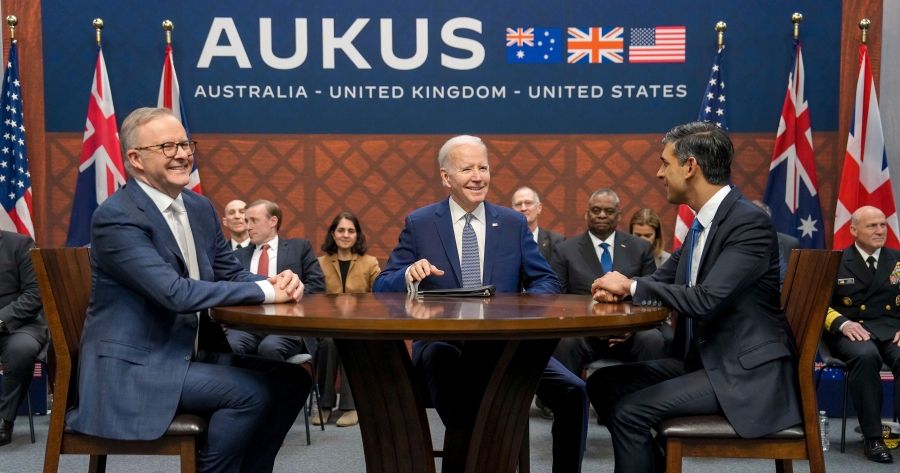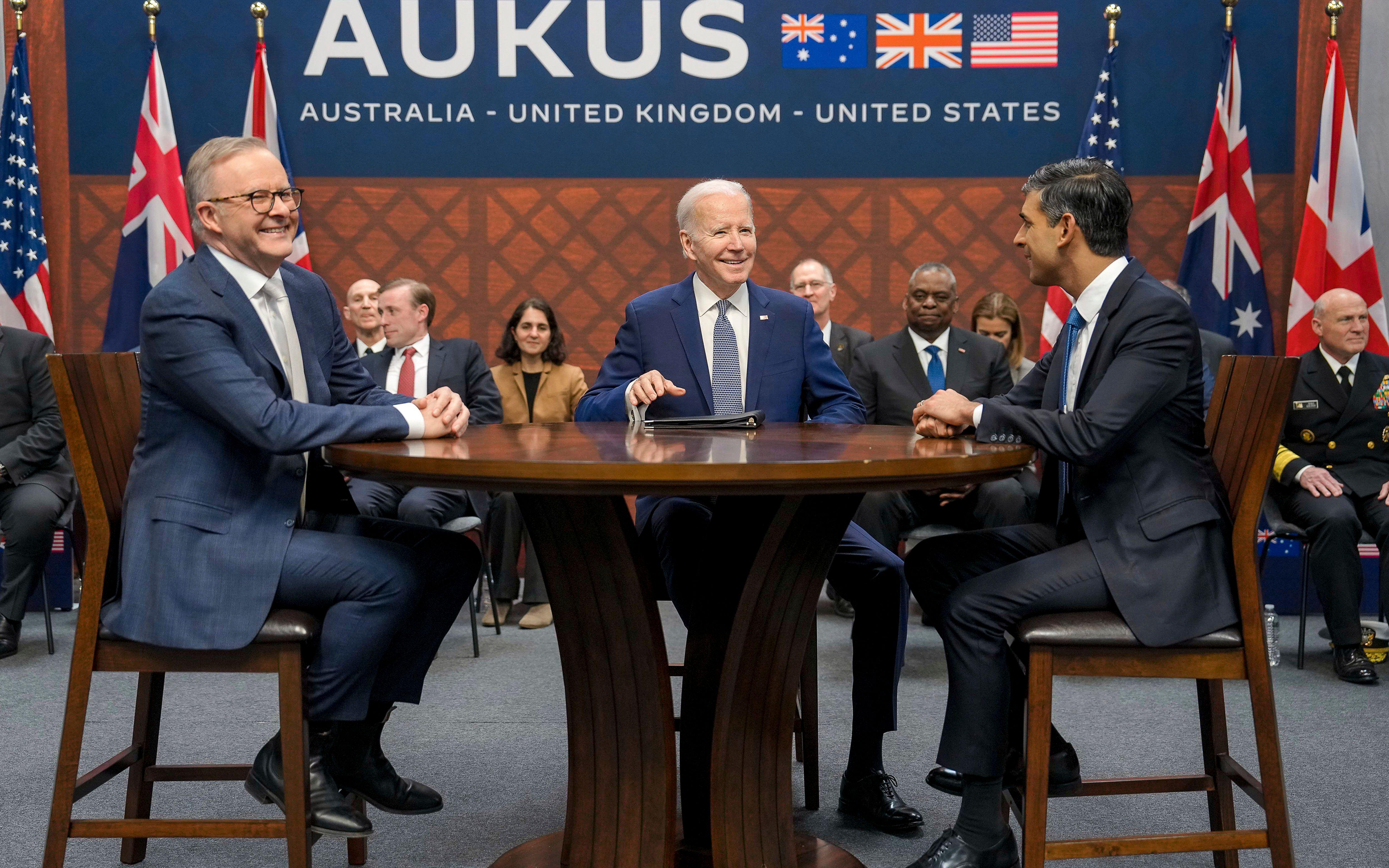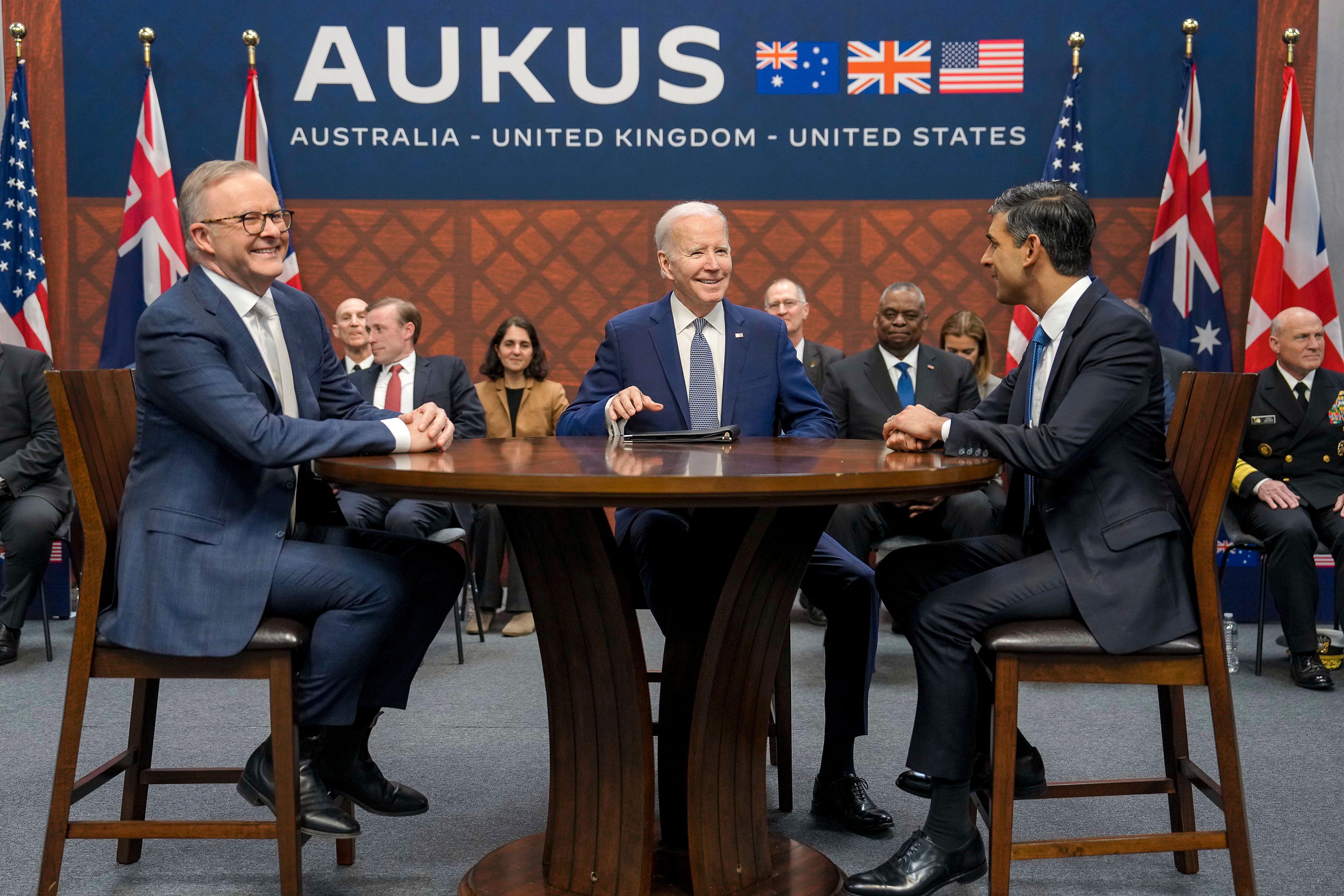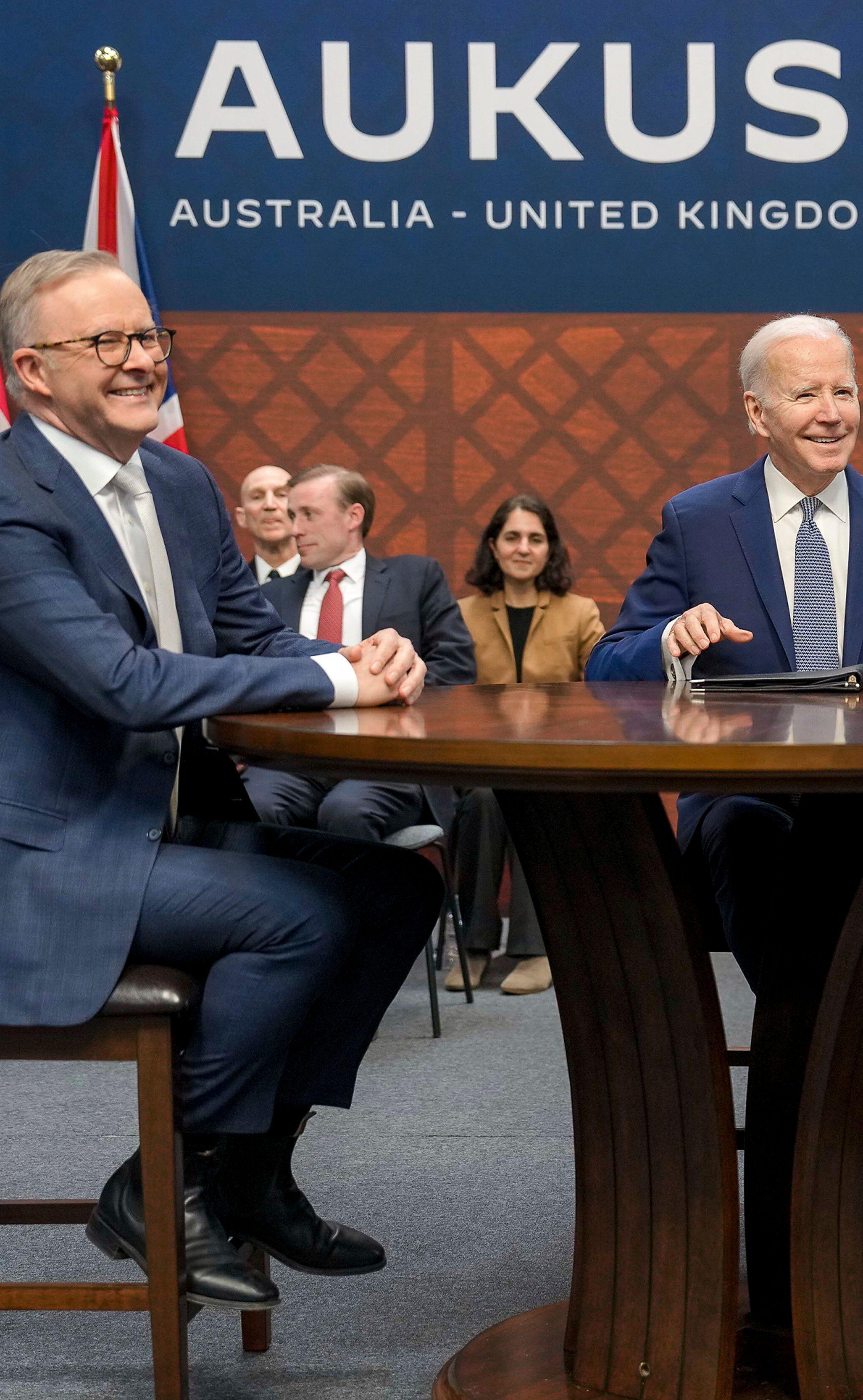
- Free Article: No
- Contents Category: Commentary
- Custom Article Title: AUKUS in the dock: Questions and challenges for the Albanese government
- Review Article: No
- Article Title: AUKUS in the dock
- Article Subtitle: Questions and challenges for the Albanese government
- Online Only: No
- Custom Highlight Text:
When the former Labor prime minister Paul Keating appeared at the National Press Club in March 2023 to savage the bipartisan commitment to acquire nuclear-powered submarines under the AUKUS agreement, he did so only days after Anthony Albanese had stood alongside his British counterpart Rishi Sunak and US President Joe Biden in San Diego to announce the ‘optimal pathway’ for the agreement. Fluttering above them were the respective flags of the three nations. In the background lay berthed the USS Missouri, a Virginia class submarine lined with American sailors and festooned with its own bunting. But as Keating noted in typically pungent fashion, on that day ‘there was only one payer: the Australian prime minister … there’s three leaders standing there … [but] only one is paying … our bloke, Albo. The other two, they’ve got the band playing, happy days are here again.’
- Featured Image (400px * 250px):

- Alt Tag (Featured Image): ‘AUKUS in the dock: Questions and challenges for the Albanese government’ by James Curran
As we approach the third anniversary of the surprise unveiling of the deal in September 2021, when Scott Morrison was prime minister, scepticism about AUKUS has only grown, and not just from Australian observers. During a recent visit to Sydney by a former senior US senior military official who had served under former president Donald Trump, Keating’s blistering remarks on the deal resurfaced. Speaking on the condition of anonymity, the American said that, although he disagreed with much of Keating’s address to the Press Club, the former prime minister was ‘absolutely right on the point that AUKUS cannot be a transfer of wealth from Australia to the United States. But now I see that you have signed two outbound cheques, one to the US and one to the British. So what Keating predicted is actually happening.’
Keating, along with strategist Hugh White, has been at the forefront in raising a number of questions related to AUKUS. They are questions the Albanese government steadfastly refuses to answer. Keating could not fathom why Albanese remained so proud of taking the decision, as Opposition leader, to back Morrison on the agreement when he was given less than twenty-four hours to consider it. Keating also lamented that there was ‘no White Paper, no major ministerial or prime ministerial statement to explain to the Australian people what exactly is the threat we are supposedly facing and why nuclear submarines, costing more than any national project since Federation, [are] the best way to respond to such a threat’. Keating wants his name ‘clearly recorded among those who say it is a mistake’.
In a long essay for Australian Foreign Affairs (issue 20, February 2024), Hugh White argued that the deeper lessons of the ‘AUKUS debacle’ will need to be confronted and learned, especially the vast gulf between ends and means, between the ‘commit[ment] to major defence capability investments without careful analysis of the outcome we want to achieve, and the most cost-effective means of achieving it’. For White, at the root of AUKUS is a failure to properly understand that Australia may, in the long run, be unable to rely on the United States to ‘keep Asia stable and Australia secure the way we have for so long’.
AUKUS, then, at its core, represents a huge strategic, intellectual, and fiscal gamble on American staying power and military industrial capacity. Just don’t expect to hear that pop out of any Australian government press briefing or political speech. AUKUS itself has been grafted onto the tribal discourse in which the United States alliance is revered and almost mysticised. As Keating and White, and indeed other analysts, have found out, to criticise any component of the agreement is to be seen as trashing a revered idol.
Like its Coalition predecessor, Labor has failed to provide a compelling strategic rationale for the acquisition of nuclear-powered submarines. Prime Minister Albanese, when he speaks about AUKUS, often boasts about the job opportunities it will create domestically, particularly in South Australia. Defence Minister Richard Marles prioritises the role the submarines will play in protecting critical trading routes in the Indian Ocean and the South China Sea, and Foreign Minister Penny Wong assures her Southeast Asian counterparts that the new capability will help create a new strategic equilibrium, or balance of power, in Asia. All three routinely confirm that the Virginia class submarines will remain under Australian sovereign control.
But the Albanese government is losing control, if it ever had it, of its AUKUS Pillar One policy. The passing of legislation through the US Congress in late 2023, which enabled so much of AUKUS Pillar Two to proceed – this part fosters deeper integration of security and defence-related science, technology, industrial bases, and supply chains – also set out strict conditions that effectively allow both a future American president and Congress to stop the submarine sale to Australia if it is not deemed to be in the US national interest, and especially if it will ‘degrade US undersea capabilities’. Australia, too, has to prove it has the capacity to operate the vessels. In essence, the conditions reveal that the United States has already plotted a path out of the project. The highly respected Congressional Research Service has also provided Congress with options for not providing the Virginias to Australia. Indeed it has come up with a proposal for what it calls a ‘US-Australia military division of labor’, whereby Australia does not acquire US nuclear-powered submarines but is instead tasked with conducting other joint US-Australian missions in the Asia-Pacific. As the report states, one option would be for Australia, ‘instead of using funds to purchase, operate, and maintain its own SSNs [to] instead invest those funds in other military capabilities (such as, for example, producing long-range anti-ship missiles and/or purchasing US-made B-21 long-range bombers), so as to create an Australian capacity for performing non-SSN military missions for both Australia and the United States’.
All of this has only made more critical swift improvements to America’s own submarine production capacity. On that front, everything appears to be pushing in the wrong direction. In May 2022, some Republicans in the US Congress requested an immediate plan from the White House to lift production of Virginia class submarines from 1.2 to a minimum of 2.5 per year, since, as they set out in their letter to President Biden, ‘the administration’s current plan requires the transfer of three US Virginia class attack submarines from the existing US submarine fleet without a clear plan for replacing these submarines’. In March 2024, however, the Biden administration ordered only one Virginia class submarine in its proposed 2025 budget, rather than the expected two. Concerns were only exacerbated by the revelation soon afterwards from the US Secretary of the Navy, Carlos Del Toro, that the production of Virginia class submarines is running two to three years late, with an unprecedented number of submarines in dry dock or requiring servicing. As Politico reported, key problems include worker shortages at many of the nation’s shipyards, especially the struggle to find skilled labourers. This is despite multiple programs to recruit and train welders and other workers in recent years.
Bear in mind too that Elbridge Colby, a former Pentagon official in the Trump administration, who is likely to serve at a senior level if Trump returns to the White House in January 2025, has strongly criticised the proposed transfer of Virginia class submarines to Australia. ‘The US has far too few available,’ he told The Australian’s Washington correspondent. ‘Many are in maintenance and the production schedule is way below what we need. We cannot and should not do something crazy. The best way to avoid a serious problem on this is for Washington and Canberra to face facts and adapt early, rather than wait until it’s too late to miss the iceberg.’
So far, Colby’s warning has not reached the policy watchtower here, though there are some in the broader Australian submarine community who have, for some time now, conceived of ways to optimise the ‘optimal’ pathway. Nevertheless, Australian government statements continue to proceed on the confident assumption that the United States will be able to turn around their submarine production rates. When Foreign Minister Wong was asked by this author what the Plan B is if the US Virginia class submarines do not materialise in time, she simply said ‘We have to make Plan A work.’ There could be no better encapsulation of the triumph of hope over experience. Little wonder that polling in March this year showed that support for AUKUS among Australians had slipped below fifty per cent.
With that growing scepticism and falling support has come a rallying cry from AUKUS advocates, both here and in the United States. The first indication, from the Australian side, has been to call for the creation of an AUKUS ‘public diplomacy arm’ along the lines of the NATO information service established at the dawn of the Cold War. Its purpose, according to its proponents, would be to ‘explain the purpose of the partnership, counter misunderstanding and disinformation of it, especially from China, and coordinate external communication of the partners’. It seeks to address the ‘cacophony of opposition’ to the agreement. To their credit, the proponents of this strategy concede that the public in all three countries need ‘to be provided with clear factual information about the intentions, processes and yes, the challenges in accomplishing the AUKUS mission’. Still, to call for a specific arm of the state to be created to push the AUKUS line reflects the level of concern that is starting to permeate the very think tanks where its strongest advocates reside.
The second came from US officialdom via the newly promoted Deputy Secretary of State, Kurt Campbell. Campbell is well known in Australian strategic circles as the author of the US ‘pivot’ to Asia under President Barack Obama, and was a key architect of AUKUS alongside Andrew Shearer, the current head of the Office of National Intelligence. Before his promotion, Campbell served as President Biden’s top White House adviser on Indo-Pacific affairs. Speaking in Washington earlier this year, Campbell admitted that the United States could do much more in reassuring its Australian and British partners on the progress of AUKUS. ‘We could tell the story better,’ he said. ‘The truth is the steps that have been taken towards AUKUS in all three countries are very substantial.’
 Anthony Albanese, Joe Biden, and Rishi Sunak during a trilateral meeting at Point Loma naval base in San Diego, California, 2023. The three leaders of the AUKUS security pact agreed to expand their nuclear-powered submarine fleet. (Adam Schultz/White House Photo/Alamy Live News)
Anthony Albanese, Joe Biden, and Rishi Sunak during a trilateral meeting at Point Loma naval base in San Diego, California, 2023. The three leaders of the AUKUS security pact agreed to expand their nuclear-powered submarine fleet. (Adam Schultz/White House Photo/Alamy Live News)
Campbell well and truly duly delivered on his promise to tell a ‘better’ story to the Australian people. But it was one which had the offices of the prime minister and defence minister caught in something of a bind: unable to respond directly to his comments and reliant solely upon their previous statements on the AUKUS agreement. Speaking in Washington in April, Campbell revealed publicly and bluntly what the AUKUS submarines are really intended for: a potential war with China over Taiwan. But he did much more than that. Campbell took a barely disguised swipe at the Albanese government’s public claims about AUKUS’s capacity for domestic job creation, and said that more money is going to be required to realise the audacious plan. That is more funding on top of the projected $368 billion the government continues to quote as the total cost for both the US Virginia class and later SSN AUKUS submarines.
In remarks delivered at the Center for a New American Security in March, Campbell spoke of the ‘practical circumstances in which AUKUS has the potential to have submarines from a number of countries operating in close coordination that could deliver conventional ordnance from long distances. Those have enormous implications in a variety of scenarios, including in cross-strait circumstances.’ The stark translation is that AUKUS submarines will be able to bomb the mainland of China. At the very least, Campbell finally let the AUKUS cat out of the bag.
The problem for Canberra is that his comments run directly counter to Albanese’s and Marles’s insistence that Australian sovereign control over operational use of the submarines would be maintained. Campbell’s intervention raises fundamental questions that the Australian government must now answer, including concerns about a likely blowout in the cost.
In February 2023, Albanese said emphatically that ‘Australia will maintain our sovereignty’ in the event of a military contingency where Canberra had a difference of view with either London or Washington. Defence Minister Richard Marles, speaking the following month, said that Australia’s ‘next-generation submarines will be Australian sovereign assets, commanded by Australian officers, and under the sovereign control of Australia’. Then, at Labor’s July 2023 party conference, a resolution passed expressly stating that AUKUS ‘does not involve any ante facto commitment to participate in, or be directed in accordance with, the military operations of any other country’. These messages do not appear to have filtered through to Washington. Even if they had, it is most unlikely Campbell would have kept them on file. A great power will do what it can and what it must.
In those same remarks in Washington, Campbell expressed particular frustration that Albanese sells AUKUS to the electorate, and especially Labor’s trade union constituency, as being primarily about job creation. Campbell said that AUKUS is ‘not a jobs program’ but rather ‘a security partnership that is profoundly constitutional and has the potential to … create fundamentally new realities on the ground really in the water in Asia’. But both the British prime minister and the US president have sold the agreement to their electorates on the basis of the employment opportunities it will create.
What Campbell meant by ‘profoundly constitutional’ is not clear. AUKUS is neither a pact nor a treaty: it is an agreement, and to this day, the terms of the agreement have not been made public. But it shows that US thinking, clear all along, has only ever been about what it perceives as Australia’s military obligations to the United States at a time of war. Campbell merely confirms what AUKUS sceptics have consistently pointed out – namely, that Washington would not transfer the jewel in its military arsenal – nuclear-powered submarines – unless it retained ultimate operational control over them.
Campbell has form. He told European Union officials privately in 2022 that AUKUS was about ‘getting Australia off the fence. We have them locked in now for the next 40 years.’ In July 2023, he said publicly that ‘when submarines are provided from the United States to Australia, it’s not like they’re lost’ to the United States. Campbell has been a chief alliance whisperer to Australian prime ministers, ministers, and officials for the best part of twenty years, holding Australian hands down the strategic aisle. But Campbell’s comments go well beyond whispers or homilies about alliance intimacy. They have serious implications for the Australia-US alliance.
It should not be forgotten that a generation of Australian leaders in the 1960s wore out a path to the White House asking the Americans to set down conclusively what the Americans understood to be their obligations to Australia’s security under the terms of ANZUS. The Americans never did, and Australia eventually gave up asking. The roles are now reversed. Campbell is now spelling out publicly the expectations Washington has of Australia to fight alongside it in the Taiwan Strait. He simply assumes Australia will be there.
Unless it changes course, and soon, the Albanese government will have a policy albatross around its neck, not only for the remainder of its time in office, but in the eyes of history. The major problem with AUKUS was of course the secrecy in which the project was originally conceived by Scott Morrison. That meant that the detailed policy consideration in Canberra concerning the risks of going down this path, not to mention the feasibility of AUKUS, was never properly assessed. But the delays besetting both the American and British shipyards now mean that the US Virginia class submarines may not be delivered at all, and that the SSN AUKUS may get caught up in the multitude of problems affecting Britain’s existing submarine construction commitments.
Nevertheless, it should not be missed that the Americans, irrespective of whether the Virginia class submarines are transferred to Australia or not, will gain much indeed – not only a golden handshake from Canberra to increase their own submarine production capacity, but also the ability to base facilities in Western Australia for their nuclear-powered submarines. Australian political leaders talk of AUKUS as the hardest, biggest project ever undertaken in the defence space. They label it a ‘whole of nation’ exercise. But while their rhetoric continues to trumpet AUKUS as the badge of Labor’s national security reliability, there remains no AUKUS tsar in the Australian public service, no Essington Lewis-type figure, to begin the mammoth task of marshalling the required resources to make it happen. Even more alarming is the ever-widening gap between the rhetoric of a deteriorating security situation and Australia’s capacity to confront it. For the next twenty years or so, Australian defence looks very much as though it will be trapped between two stools, between the diagnosis of strategic urgency and the reality of bureaucratic inertia and apathy.
This article is one of a series of ABR commentaries on cultural and political subjects being funded by the Copyright Agency's Cultural Fund.



Comments powered by CComment